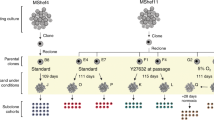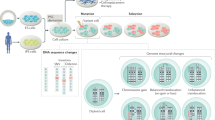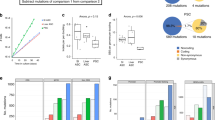Abstract
Cultured human embryonic stem cell (hESC) lines are an invaluable resource because they provide a uniform and stable genetic system for functional analyses and therapeutic applications. Nevertheless, these dividing cells, like other cells, probably undergo spontaneous mutation at a rate of 10−9 per nucleotide. Because each mutant has only a few progeny, the overall biological properties of the cell culture are not altered unless a mutation provides a survival or growth advantage. Clonal evolution that leads to emergence of a dominant mutant genotype may potentially affect cellular phenotype as well. We assessed the genomic fidelity of paired early- and late-passage hESC lines in the course of tissue culture. Relative to early-passage lines, eight of nine late-passage hESC lines had one or more genomic alterations commonly observed in human cancers, including aberrations in copy number (45%), mitochondrial DNA sequence (22%) and gene promoter methylation (90%), although the latter was essentially restricted to 2 of 14 promoters examined. The observation that hESC lines maintained in vitro develop genetic and epigenetic alterations implies that periodic monitoring of these lines will be required before they are used in in vivo applications and that some late-passage hESC lines may be unusable for therapeutic purposes.
This is a preview of subscription content, access via your institution
Access options
Subscribe to this journal
Receive 12 print issues and online access
$209.00 per year
only $17.42 per issue
Buy this article
- Purchase on Springer Link
- Instant access to full article PDF
Prices may be subject to local taxes which are calculated during checkout


Similar content being viewed by others
References
Matsuzaki, H. et al. Genotyping over 100,000 SNPs on a pair of oligonucleotide arrays. Nat. Methods 1, 109–111 (2004).
Maitra, A. et al. The Human MitoChip: a high-throughput sequencing microarray for mitochondrial mutation detection. Genome Res. 14, 812–819 (2004).
Toyooka, K.O. et al. Establishment and validation of real-time polymerase chain reaction method for CDH1 promoter methylation. Am. J. Pathol. 161, 629–634 (2002).
Hodgson, J.G., Chin, K., Collins, C. & Gray, J.W. Genome amplification of chromosome 20 in breast cancer. Breast Cancer Res. Treat. 78, 337–345 (2003).
Mahlamaki, E.H. et al. Frequent amplification of 8q24, 11q, 17q, and 20q-specific genes in pancreatic cancer. Genes Chromosomes Cancer 35, 353–358 (2002).
Fearon, E.R. & Vogelstein, B. A genetic model for colorectal tumorigenesis. Cell 61, 759–767 (1990).
Popescu, N.C. & Zimonjic, D.B. Chromosome-mediated alterations of the MYC gene in human cancer. J. Cell. Mol. Med. 6, 151–159 (2002).
Fliss, M.S. et al. Facile detection of mitochondrial DNA mutations in tumors and bodily fluids. Science 287, 2017–2019 (2000).
Wang, Y. et al. Muscle-specific mutations accumulate with aging in critical human mtDNA control sites for replication. Proc. Natl. Acad. Sci. USA 98, 4022–4027 (2001).
Baylin, S.B. & Herman, J.G. DNA hypermethylation in tumorigenesis: epigenetics joins genetics. Trends Genet. 16, 168–174 (2000).
Toyota, M. et al. CpG island methylator phenotype in colorectal cancer. Proc. Natl. Acad. Sci. USA 96, 8681–8686 (1999).
Reddy, J. et al. Differential methylation of genes that regulate cytokine signaling in lymphoid and hematopoietic tumors. Oncogene 24, 732–736 (2005).
Shivapurkar, N. et al. Aberrant methylation of trail decoy receptor genes is frequent in multiple tumor types. Int. J. Cancer 109, 786–792 (2004).
Dammann, R. et al. Epigenetic inactivation of a RAS association domain family protein from the lung tumour suppressor locus 3p21.3. Nat. Genet. 25, 315–319 (2000).
Burbee, D.G. et al. Epigenetic inactivation of RASSF1A in lung and breast cancers and malignant phenotype suppression. J. Natl. Cancer Inst. 93, 691–699 (2001).
Pfeifer, G.P. et al. Methylation of the RASSF1A gene in human cancers. Biol. Chem. 383, 907–914 (2002).
Draper, J.S. et al. Recurrent gain of chromosomes 17q and 12 in cultured human embryonic stem cells. Nat. Biotechnol. 22, 53–54 (2004).
Brimble, S.N. et al. Karyotypic stability, genotyping, differentiation, feeder-free maintenance, and gene expression sampling in three human embryonic stem cell lines derived prior to August 9, 2001. Stem Cells Dev. 13, 585–597 (2004).
Buzzard, J.J., Gough, N.M., Crook, J.M. & Colman, A. Karyotype of human ES cells during extended culture. Nat. Biotechnol. 22, 381–382 (2004).
Rosler, E.S. et al. Long-term culture of human embryonic stem cells in feeder-free conditions. Dev. Dyn. 229, 259–274 (2004).
Rugg-Gunn, P.J., Ferguson-Smith, A.C. & Pedersen, R.A. Epigenetic status of human embryonic stem cells. Nat. Genet. 37, 585–587 (2005).
Huang, J. et al. Whole genome DNA copy number changes identified by high density oligonucleotide arrays. Hum. Genomics 1, 287–299 (2004).
Livak, K.J. & Schmittgen, T.D. Analysis of relative gene expression data using real-time quantitative PCR and the 2(−ΔΔC(T)) Method. Methods 25, 402–408 (2001).
Sait, S.N. et al. Double minute chromosomes in acute myeloid leukemia and myelodysplastic syndrome: identification of new amplification regions by fluorescence in situ hybridization and spectral karyotyping. Genes Chromosom. Cancer 34, 42–47 (2002).
Cutler, D.J. et al. High-throughput variation detection and genotyping using microarrays. Genome Res. 11, 1913–1925 (2001).
Herman, J.G., Graff, J.R., Myohanen, S., Nelkin, B.D. & Baylin, S.B. Methylation-specific PCR: a novel PCR assay for methylation status of CpG islands. Proc. Natl. Acad. Sci. USA 93, 9821–9826 (1996).
Acknowledgements
We thank J. Gearhart and C. Dang for comments and suggestions and J. LaDuca for carrying out FISH analysis. A.C. is supported by the Henry J. Knott Professorship in Genetic Medicine. A.M. is supported by the Sol Goldman Pancreatic Cancer Research Center at Johns Hopkins and a grant from the Maryland Cigarette Restitution Fund. A.C. and D.E.A. are supported by the Donald W. Reynolds Foundation Clinical Cardiovascular Research Center grant to Johns Hopkins University. A.F.G. is supported by the National Cancer Institute Early Detection and Research Network. The work related to lines BG01, 02 and 03 was partially supported by a grant from the US National Institutes of Health to BresaGen. The work related to lines SA001 and SA002/2.5 was partially supported by a grant from the US National Institutes of Health to Cellartis AB. A.C. is a paid member of the Affymetrix Scientific Advisory Board. The terms of this arrangement are being managed by Johns Hopkins University in accordance with its conflict of interest policies.
Author information
Authors and Affiliations
Corresponding authors
Ethics declarations
Competing interests
T.C.S. and S.N.B. are employed by BresaGen; their research is partially funded by BresaGen; and they may own stock options in BresaGen. J.C., S.A. and A. Colman are employed by ES Cell International; their research is partially funded by ES Cell International; and they may own stock options in ES Cell International.
Supplementary information
Supplementary Fig. 1
Comparison of copy number status between earlier and later passage hESC lines. (PDF 292 kb)
Supplementary Fig. 2
Confirmation of array-based copy number alterations in hESC lines. (PDF 157 kb)
Supplementary Table 1
Summary of SNP changes during cell culture of hES cells. (PDF 8 kb)
Supplementary Table 2
H1 has both reduced heterozygous calls, and reduced overall call rates in the deleted region on chromosome 18. (PDF 11 kb)
Supplementary Table 3
Summary of Q-MSP data. (PDF 13 kb)
Rights and permissions
About this article
Cite this article
Maitra, A., Arking, D., Shivapurkar, N. et al. Genomic alterations in cultured human embryonic stem cells. Nat Genet 37, 1099–1103 (2005). https://doi.org/10.1038/ng1631
Received:
Accepted:
Published:
Issue Date:
DOI: https://doi.org/10.1038/ng1631
This article is cited by
-
TPX2 Amplification-Driven Aberrant Mitosis in Culture Adapted Human Embryonic Stem Cells with gain of 20q11.21
Stem Cell Reviews and Reports (2023)
-
Discovery and characterization of heterogeneous and multipotent fibroblast populations isolated from excised cleft lip tissue
Stem Cell Research & Therapy (2022)
-
Identification and characterisation of spontaneous mutations causing deafness from a targeted knockout programme
BMC Biology (2022)
-
Implications of mitochondrial DNA mutations in human induced pluripotent stem cells
Nature Reviews Genetics (2022)
-
p53 at the crossroad of DNA replication and ribosome biogenesis stress pathways
Cell Death & Differentiation (2022)



